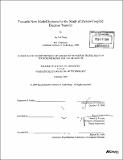| dc.contributor.advisor | Daniel G. Nocera. | en_US |
| dc.contributor.author | Yang, Jay Lee | en_US |
| dc.contributor.other | Massachusetts Institute of Technology. Dept. of Chemistry. | en_US |
| dc.date.accessioned | 2009-08-26T17:12:44Z | |
| dc.date.available | 2009-08-26T17:12:44Z | |
| dc.date.copyright | 2009 | en_US |
| dc.date.issued | 2009 | en_US |
| dc.identifier.uri | http://hdl.handle.net/1721.1/46651 | |
| dc.description | Thesis (S.M.)--Massachusetts Institute of Technology, Dept. of Chemistry, 2009. | en_US |
| dc.description | Vita. | en_US |
| dc.description | Includes bibliographical references (p. 44-45). | en_US |
| dc.description.abstract | Two new model systems for the study of orthogonal proton-coupled electron transfer (PCET) have been developed. The first model system is based on Ru"(HzO)(tpy)(bpy) (tpy = 2,2';6',2"terpyridine, bpy = 2,2'-bipyridine) where methyl viologen (MV2 ) electron acceptors were appended to the ruthenium aqua complex through the bpy. Picosecond transient absorption measurements show that electron transfer from the excited state of the ruthenium complex to MV2+ occurs with [tau] -200 ps. Experiments performed in water and buffered solution at pH = 7 show no evidence of the loss of proton from the aqua ligand to the bulk solvent or to the phosphate buffer. A minor kinetic isotope effect for the rate of charge separation was found with kH/kD = 1.8 + 0.1 ps. Preliminary synthetic attempts of coupling the ET event to the PT event was accomplished by appending xanthene "Hangman" scaffolds to the 4' position of the tpy. The feasibility of modifying the xanthene scaffold to accommodate various hanging groups has been demonstrated. The second model system is based on Re'(CO)3(phen)(pyr) (phen = 1,10phenanthroline, pyr = pyridine) where tyrosine was appended to the rhenium complex through the axial pyr ligand. Unlike previous Re'(CO)3(bpy)(CN) (CN = cyanide) systems, substitution to the more rigid phen extended the lifetime of the excited state of the rhenium complex to 3.0 ls, which allowed PCET to occur from the tyrosine to the rhenium metal center and hydrogenbonded base in dichloromethane. This was inferred from substantial emission quenching of the rhenium-tyrosine complex through the titration of base (base = pyridine, imidazole, 2,4,6trimethylpyridine). Equilibrium constants measuring the extent of formation of the [rheniumtyrosine---base]+ species were found to correlate with the strength of the base based on aqueous pKa values. | en_US |
| dc.description.statementofresponsibility | by Jay Lee Yang. | en_US |
| dc.format.extent | 46 p. | en_US |
| dc.language.iso | eng | en_US |
| dc.publisher | Massachusetts Institute of Technology | en_US |
| dc.rights | M.I.T. theses are protected by
copyright. They may be viewed from this source for any purpose, but
reproduction or distribution in any format is prohibited without written
permission. See provided URL for inquiries about permission. | en_US |
| dc.rights.uri | http://dspace.mit.edu/handle/1721.1/7582 | en_US |
| dc.subject | Chemistry. | en_US |
| dc.title | Towards new model systems for the study of proton-coupled electron transfer | en_US |
| dc.type | Thesis | en_US |
| dc.description.degree | S.M. | en_US |
| dc.contributor.department | Massachusetts Institute of Technology. Department of Chemistry | |
| dc.identifier.oclc | 426941872 | en_US |
